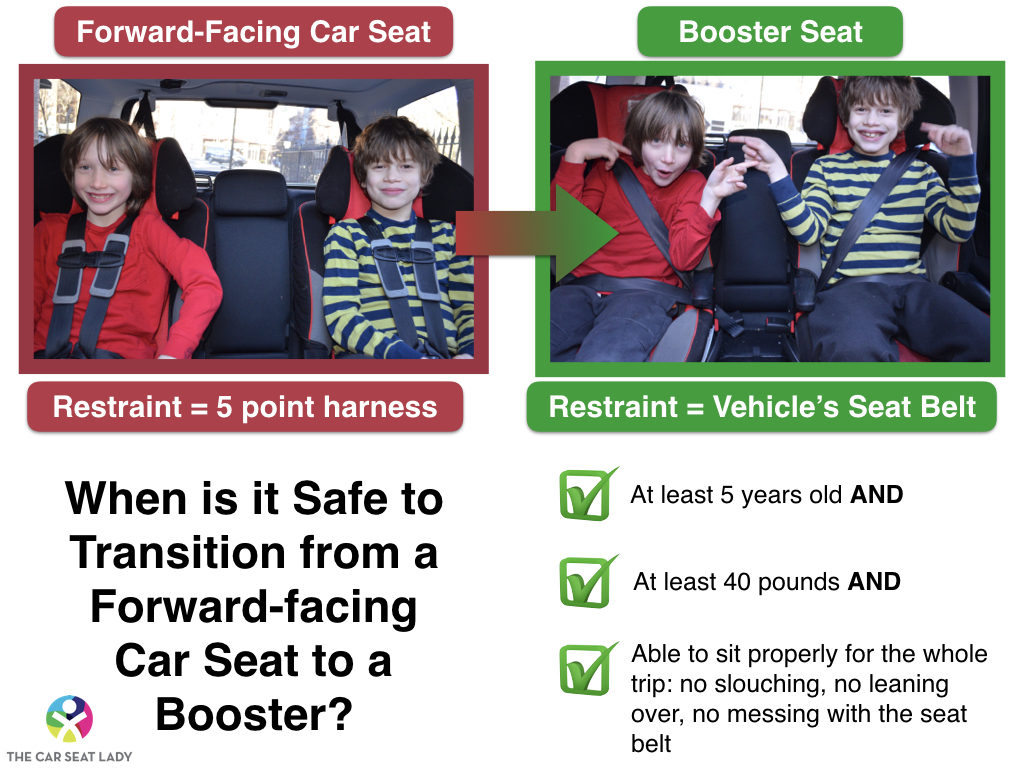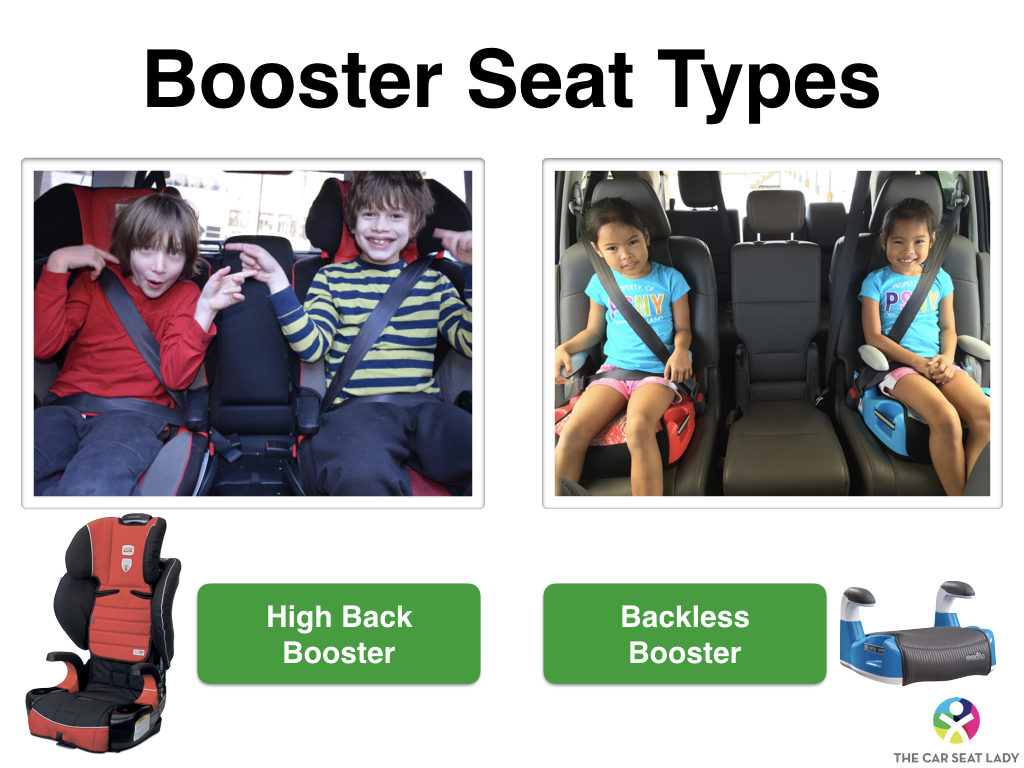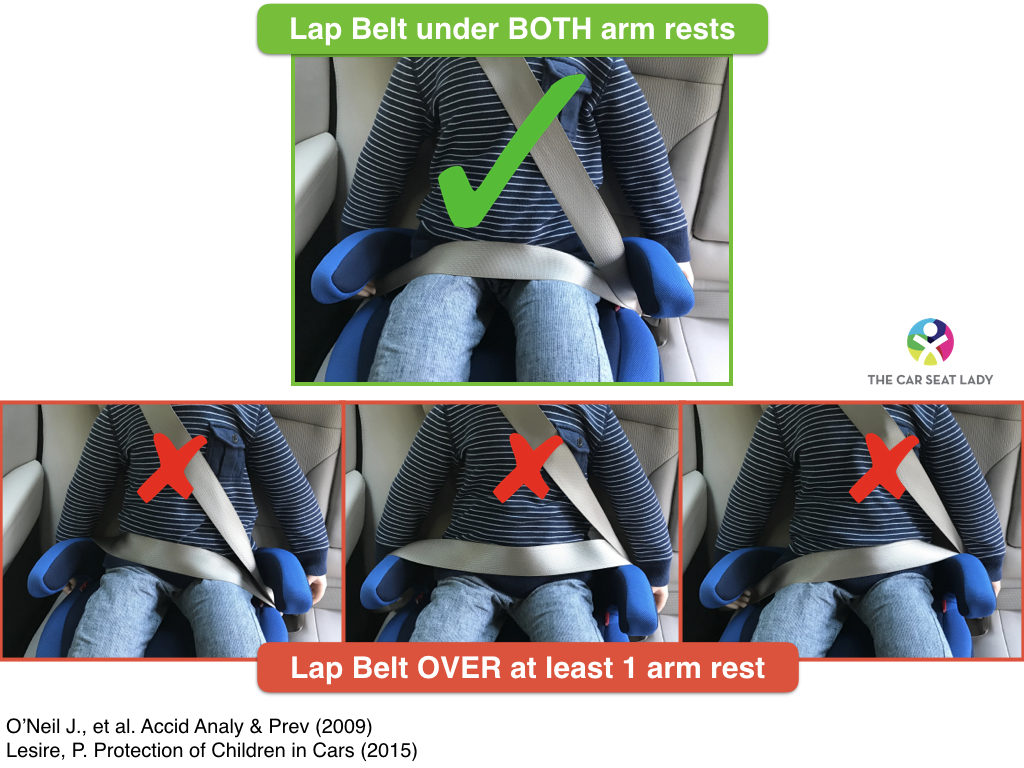First of all, let’s make sure we’re on the same page – a booster is a seat where the child sits on it and uses the vehicle’s seat belt as their restraint. A car seat is a seat the child sits in and uses a 5-point harness (car seat straps) as their restraint.
Yes, there are seats that can do double duty – starting as car seats and turning into boosters. This can be a bit confusing! With these seats if your child is using the 5 point harness then they are riding in a car seat…and if your child is sitting on the child restraint and using the vehicle’s seat belt across them, then they are riding in a booster.
What does the booster do? A booster positions the vehicle’s safety belt properly on a child. The booster makes sure that the lap belt rests on the child’s lap, over the strong hip bones – and nowhere near the soft belly. The booster also makes sure that the shoulder belt rests between the child’s shoulder and neck.
If you can answer “Yes” to ALL the statements below, your child is safe to use a booster:
Young children under age 5 or 6 are safer in a 5-point harness car seat. Don’t rush to “graduate” your child to a booster seat. If your 5 or 6 year old still fits in their 5-point harness car seat, leave them there!

The 5-point harness of a forward-facing car seat provides the best protection for pre-schoolers because it not only restricts movement, ensuring that toddlers are in the proper position should a crash occur, but also distributes the crash forces over a larger area of the body when compared to a safety belt and booster seat (two chest straps with the car seat’s 5-point harness versus one chest strap with the seat belt.). While some booster seats allow use for children weighing as little as 30 pounds, it’s best to wait until the child is at least 40 pounds (and has met the other minimums stated above) before using a booster seat.
No! Many 40 pound children are not mature enough to use a booster seat. Boosters require that a child sit in the proper position (on the booster) for the entire car ride. Does your over-40-pound child do any of the following in the car?
A child who does any of these (and other similar behaviors) is not ready for a booster, even if they meet the booster’s minimum age, height and weight. These behaviors, which can be age appropriate for a 5 or 6 year old, show that the child simply needs a 5-point-harness that can accommodate a taller, heavier child.
Since most kids are too tall (their shoulders reach the top shoulder strap slot) long before too heavy in their forward-facing car seat, choosing a seat with the highest shoulder strap slots will allow your child to use the 5-point harness for longer. The Chicco MyFit and Britax One4Life ClickTight have the highest shoulder strap slots of seats currently on the market. The MyFit is narrower and has a slightly higher strap height, 19.75 inches to 19 inches on the One4Life. Both of these seats have seat belt locking devices allowing for an easy installation for children up to 65 lbs.
Kids need booster seats to help the seat belt fit properly on the strong, bony parts of their body (their hip bones, sternum, and collar bone) and to help their body fit properly on the vehicle seat. The lap belt is the hidden danger. A poorly positioned lap belt is what sends kids to the hospital.
Boosters help the seat belt start and stay on the bony parts of a child’s body during normal driving and in a crash.
By raising the child up (boosting them!!), boosters help the shoulder belt fit properly between the shoulder and the neck. By raising the child up and providing a shorter seat pan, a booster lets the child’s knees bend at the booster’s edge, making the child more comfortable and much less likely to slouch. Slouching is very dangerous because it puts the lap belt up on the belly which can cause very serious injuries to the abdominal organs and spinal cord in a crash.
Boosters have design features that help the lap belt start and stay on the lap during a crash. Many boosters use arm rests to do this. Boosters that earn a “Best Bet” from the Insurance Institute for Highway Safety are the most likely to provide good lap and shoulder belt fit for typical 4-8 year old kids in almost any vehicle.
See here for a very in-depth discussion of exactly how and why boosters work so well for children.

For kids who like to sleep in the car, choose a high-back booster that has a recline and a well designed head rest. These design aspects can help the child sleep better and longer while keeping their body better positioned in the seat belt during sleep.
Use a backless booster when it’s not practical to bring a high back booster, like when you’re going in an Uber/taxi/Lyft, or when your child’s going in a friend’s car and you aren’t sure that they have an spare booster. Of course you should also use a backless booster when your child has outgrown their high back booster’s height limit, but have not yet passed the 5-Step-Test.
When using any backless booster and some high back boosters – specifically those where the back is somewhat flimsy – the vehicle seat needs to support up to at least the top of the child’s ears to decrease the chance of the child getting whiplash. The vehicle seat refers to either the seat itself or the head restraint (if the vehicle has one there); some part of the vehicle’s structure must support up to the top of the ears. If the seat back is not tall enough, then the child needs to use a high back booster that does not require a headrest behind the booster. This information should be in the booster’s instruction manual, and if you aren’t sure about your booster’s requirements just give the manufacturer a call.

Do you see the errors here? Most boosters have “arm rests” that the lap belt must go under to ensure that it starts and stays on your child’s strong hip bones in a crash, instead of moving up into the child’s soft belly. Studies show that nearly half of all boosters are misused in the same way, where the lap belt is accidentally placed over one or both of the arm rests. This misplacement is exceptionally dangerous because it puts the lap belt on the child’s belly, where it can cause terrible injuries in a crash.
Some boosters are cleverly designed to eliminate this type of misuse! We loved the now discontinued Maxi Cosi RodiFix for a variety of reasons, but one biggie is that Maxi Cosi designed this booster so that it had no arm rests! It offered a great seat belt fit and no arm rests meant it was easier for kids to buckle up properly every single time they used their booster.
Read your booster’s manual carefully to see where the shoulder belt goes – it usually goes under the arm rest closest to the seat belt buckle, but there are a few exceptions where it goes over the arm rest.
Yes! Slouching is VERY dangerous in a car – whether you are a kid in a booster, or a big kid/adult in a seat belt – as slouching pulls the lap belt into the belly – which means all the forces of the crash are on the soft abdominal organs like the kidneys, liver, spleen, intestines, and worst of all the spinal cord rather than on the strong hip bones. Slouching also makes the seat belt very loose, which allows the whole body to move more than it should in a crash – but in particular the head moves a lot farther forward and is much more likely to hit the back of the front seat – which causes both brain and neck injuries.
Kids need a booster seat until the seat belt fits properly on their body without the help of a booster (the lap belt is on their lap and the shoulder belt is between the neck and shoulder) AND their body fits properly on the vehicle seat (they can sit back with their knees bent without having to slouch). Studies show that half of all 10 year olds need a booster seat to ride safely – and by 12, almost every child is ready to ride safely without a booster.

If you need to fit 2 car seats next to each other, or 3 car seats across one row, these boosters are the seats for you.
The best booster seats for your bigger-than-average kiddo, with safety, comfort, and longevity in mind.
We are a reader supported site. We earn an affiliate commission when you buy through our links.
FTC Disclosure: Affiliate links are included in this page. No monetary compensation was provided, however, some of the reviewed products were supplied by the manufacturer or distributor to help facilitate the review. All opinions are those of The Car Seat Lady LLC.
